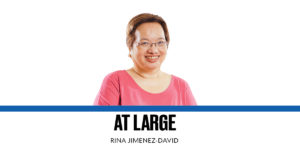Next week a new semester begins, and I enter a classroom again very much as I have done so the past three decades, the first meeting always accompanied by a feeling of expectation and dread.
Ninety-four pairs of eyes will follow me as I descend into the lecture hall. With tiered seating, I can scan the fresh new faces who also come with many different expectations of what the so-called “Ambeth Ocampo Experience” talked about in campus is really like.
Students also dread the horror stories: challenging test questions and low grades made lower by an eccentric class policy that cancels the highest mark in papers and exams. Other teachers give their students slack by canceling the lowest score to allow for bad hair days, but canceling the highest is more challenging as it rewards consistency. For example, you have three Fs and one A; canceling the highest removes the wild card from the deck. But if you have three Bs and one canceled A, your average will still be what you truly deserve.
I have taught long enough to have experienced the evolution from chalk and blackboards to markers and whiteboards. Every year, there is always an inconsiderate teacher who cannot tell the difference between a permanent and erasable marker, leaving his or her chicken scrawl and stupidity on the board for everyone to see.
I remember teachers who were conferred the “Hieroglyphics Award” and came to class next semester with their notes legibly written with Pentel pen on large uncut sheets of Manila paper that they then attached to the board with masking tape. For them, the great leap forward was the introduction of the overhead projector, with notes printed on acetate or used plastic bags. Around this time, some teachers also used carousel slide projectors that made a distinctive clicking sound as it changed pictures, in a classroom so dark it hid the sleepy heads and the munchers who ate their “baon” under the cover of darkness. That darkness also made for furtive physical displays of affection when the teacher’s back was turned.
Teachers today now use PowerPoint or Keynote to project text and visuals on a screen from their laptops, tablets or cell phones. Film and sound are not a problem, provided you have the required cables to connect to speakers and screen, so there is no excuse for a teacher to be boring. Except that some teachers have not adapted their teaching to the technology they use, the best example being those that crowd the slide with text instead of keeping it to short keywords. Worse, these teachers turn their backs on the students and slowly read the text on the screen to the bored students, who read it with their eyes faster than the teacher can verbally go through each painful word.
My classroom is paperless. All the required readings are uploaded to a teaching app; this has reduced the income of photocopying services and the trees cut for paper. All submissions are online, further reducing paper consumption and making it difficult for excuses such as “the dog chewed up my assignment.”
As I loaded my syllabus and assignments on the app recently, I thought about a time when students had to carry a heavy load of notebooks and textbooks to school daily. I have some of these old textbooks, and through their pages, one can trace the emergence of the nation and how the young were molded into citizens in different times.
“A Philippine Insular Primer” printed in New York in 1899 taught tropical children about snow and acorns; their flag was the Stars and Stripes, and their hero George Washington as he appeared in the US dollar. There were the prewar “Philippine Readers” by Camilo Osias that carried delightful illustrations by Fernando C. Amorsolo. Shortly before the war, in 1940, there were the “Philippine Public School Readers” that showed both the US and Philippine flags, because we were then the Commonwealth of the Philippines. Today, our K-to-12 textbooks have the flag of the Philippines alone, and “Lupang Hinirang” is the anthem of a Philippines long liberated from Spanish, American and Japanese rule.
I look at these old textbooks and wonder what adjustments I need to make teaching college-level “Philippine History from Primary Sources” to incoming students from the K-to-12 system who are equipped with only one dedicated Philippine history subject in Grade 4.
Comments are welcome at aocampo@ateneo.edu.


